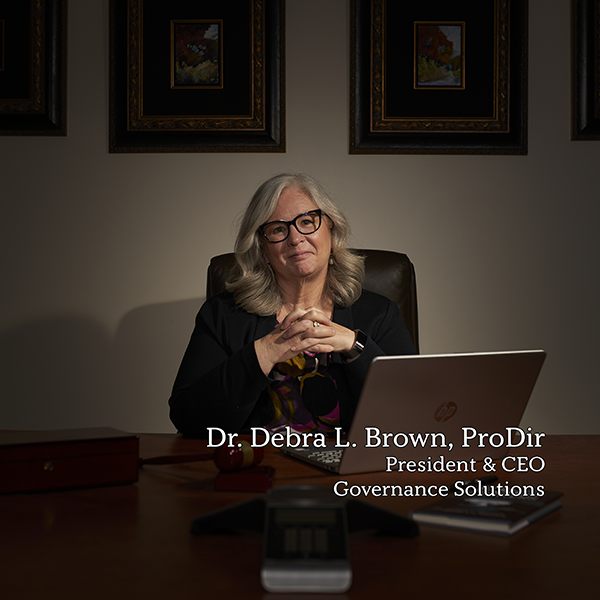5 Steps to Your Board Seat
By Dr. Debra L. Brown
 For plenty of executives, a board seat is an aspirational goal. Why is that? There’s the money, of course.
For plenty of executives, a board seat is an aspirational goal. Why is that? There’s the money, of course.
The average total director compensation was $312,000, according to the U.S. Spencer Stuart Board Index.
Then too, it’s a big career boost. Research published in the Harvard Business Review found that when an executive snags a board seat, they are 44% more likely to be promoted as a first-time CEO to an S&P 1500 firm. And even if they don’t get that promotion, their annual pay goes up by 13%.
It’s also an opportunity to cycle off the daily grind of C-suite life. If you’re inclined to walk away from the day-to-day work of running a company, a board seat is a great way to put your skills to work without the constant stress of a full-time leadership role.
And it’s a chance to give back. With years of experience, now you have a chance to guide and advise everybody from burgeoning startups, eager for a steady hand, to generations-old corporations that need to pivot to address today’s challenges.
Ready to sign up? We’ve got good and bad news.
The bad news is this: Securing a board seat often involves a highly competitive process that culminates after years of networking.
And the good news: As they hunt for their next board member, today’s companies are seeking depth and breadth in experience and perspective.
Boards don’t just want a generic “leader.” As the world gets more complicated, companies need experts in everything from technology and digital transformation to diversity, equity and inclusion, and global business practices on their boards.
And, as a response to global social justice movements and to ensure companies are serving increasingly diverse consumer bases, they’re on the lookout for board members from all backgrounds. According to SpencerStuart’s Nominating/Governance Chair Survey 2021, the new class of S&P 500 directors is the most racially and ethnically diverse ever. Some 72% of new independent directors are from underrepresented groups, including women and people of color—up from 59% the year before.
But just because corporations have opened their boardroom doors wider, getting a seat is still no walk in the park. For those just beginning their journey, the process can seem shrouded in mystery. Take heart: Somewhere out there is an organization that needs your expertise and perspective, and there are steps you can take right now to set yourself up for success.



1. Know Them: Know the Aspirations of Your Audience
Not that long ago, it was easy to figure out who board members were looking for when they needed somebody new to join their fold. It was their friend at the golf course. Their old college buddy. A former co-worker. They looked to people in their network who had risen to the C-suite in their respective companies, often CEO. And that was enough.
For decades, boards filled vacant seats through personal connections. And, because of longtime practices and biases that have made it difficult, if not impossible, for women and people of color to rise through the ranks, new board members looked no different than the board members they replaced: They were pretty much all white men.
For all the right reasons, the path to the boardroom is different today. No longer is it exclusively an enclave for older white male executives. Increasingly, the faces in boardrooms are reflective of the diverse world we live in.
In other words, while the general business expertise of a CEO might have been enough for boards a generation ago, it isn’t anymore. Boards need a broad range of executives with very specific expertise to help address the complicated nature of today’s business decisions.
That’s why companies are increasingly laser-focused on building a board that acts as a collective mind — where each individual represents distinct interests, competencies, and skills that, as a whole, provides the answers and innovations required to operate in this fast-changing environment.
As board seats open up, board members typically run through a series of exercises to determine the experience, skills, knowledge, education, and diversity of those who remain at the table and the gaps they need to fill because of the current exit.
You will want to understand what their skills matrix is calling for and where they may have gaps that you are uniquely equipped to fill.
2. Show Them: Craft Your Resume
Now that you know what their aspirations are for their next board member. Craft your resume.
When considering applying for a board seat, read through the desired profile. And then read through it again. Take note of specific attributes, skills, and experience that the board is looking for. Pull out that information and start to think about how you can fill in their gaps.
Remember: This isn’t about what you need. When applying, the focus is on providing boards with what they need. Once you have a thorough understanding of what their needs and gaps are, you can then start to craft your response by putting together a résumé that shows off why you are the person for the job.
Just like on the job hunt, you likely won’t check yes on every single requirement for a board seat. The perfect fit is exceedingly rare. It’s unlikely there are many people who have served in both senior IT and HR roles, for example. As you peruse board member listings, don’t be discouraged if you have little experience in one or two of the categories. Your application is about showing off the expertise that you do have.
"You must craft a board résumé specifically for each opportunity.
And a board résumé is different from a résumé for a traditional job."
Dr. Debra L. Brown
You probably have an executive résumé that’s carefully crafted to fill the general needs of headhunters or potential employers as you look to step up in your career. It demonstrates your ability to lead with excellence and likely lists your academic and career history, the quantitative and qualitative results of your leadership, and how you fit within the hierarchy of the organization’s leadership. That résumé is a starting point as you begin to apply for board seats, but it isn’t enough to land you one.
You need to craft your board résumé — your sales pitch — to the specific needs of the board. And you need to reframe it through the lens of your experience in setting direction and overseeing organizational results. Board members are not expected to be tacticians. They are expected to be able to step back, direct and oversee. You will need to demonstrate your ability to do so.
3. Reach Them: Network Digitally
"Many boards still use the “I know a guy” method of choosing directors,
so networking is still needed, and visibility is a must."
Dr. Debra L. Brown
You probably didn’t secure your current job from simply responding to a job advertisement — and it’s highly unlikely you’ll win a board seat by scanning the classifieds, too. Today’s job searches — whether for hourly shift work, a C-suite position, or a board seat — are often all about networking. Teens get leads on first jobs from their network of friends — and parents’ friends. Professionals move up the ladder after years of building their own network of colleagues and with the help of professional networkers — executive search firms with tentacles that reach even further.
To get a board seat, today’s candidates must move forward with a multi-pronged approach that includes not just scouring online listings and perfecting their board résumé. They also must build an authentic personal and professional network and finetune their brand and online presence.
Board members and human resources professionals are increasingly using their own networks and targeted searches through executive placement firms to find candidates. What’s more, they’re more often relying on artificial intelligence tools to scour websites and social media platforms for candidates who fit their profile.
Here are some steps you can take:
- Start by connecting digitally with people you know, including referrals and contacts. LinkedIn is a perfect place for this
- Build a relationship with those existing contacts by following what they are up to
- Ask for introductions to their connections
- Ask someone to review your résumé
- Share success stories
- Follow up
- Help them out
- Thank them




4. Stand Out to Them: Nail the Interview
The good news is that you already did a thorough review of the candidate profile when you customized your resume, so you should already have insight into what is important to the board.
You already know what skills and competencies they are looking for, so you will want to have stories prepared that would show your knowledge in those areas; stories that show them you can use that knowledge in a board setting.
The art of nailing the interview is all about storytelling, especially if they use behavioural interview questions, which they most likely will. Behavioural interview questions are designed to get you to tell a story, to show how you behave and work with others. They usually start with “tell me about a time.” This begs for a good story!
You should develop at least 15 to 20 stories about yourself. You might have to dig deep to find the successes you have had that can be applied to the boardroom setting. These should be stories that explain who you are, how you lead, and what is important to you.
It will take time to develop your stories, but it is time well spent. Know yourself and build your stories based on your uniqueness, skills, character attributes, and personality. It can’t be a façade. It’s about who you are, what you stand for, and what you can bring to the table. The more authentic the stories and the more practiced you are at telling them the better your interviews will be.
This is no time for false humility. Building a personal brand is about showing people who you are and what you have to offer.
Interviewing well is an art and a skill that needs to be kept sharp. Try to find someone to interview with. Practice sharpens the message and keeps you from becoming a rambler.
5. Impress Them: Get Your Professional Director® Designation
Serving on a board is neither a hobby nor a pastime, not a way for a particular shareholder to get their way, nor an opportunity to supplant oneself as the de facto CEO. Rather, it is a trusted fiduciary position at the very top of an organization, that requires special training and skill.
A Professional Director® has impeccable character and emotional maturity, is engaged and qualified in governance, knows and fulfills their role, and asks profound questions. They are courageous, certain, curious, and confident, and above all, they are competent in corporate governance and the application of governance principles and practices. This is because they have studied the profession and earned their designation.
If a board is faced with two great potential board candidates and one has their governance designation, and the other does not, they will choose the one with the designation a hundred times out of a hundred.
Here at Governance Solutions, we know what it’s like to be in your shoes. Through our Professional Director Education and Certification Program®, we’ve worked with hundreds of aspiring board members just like you. Once they graduate, they are ready and eager to serve. Their designation helps them secure that coveted board seat.
Find out more about becoming a Professional Director®

